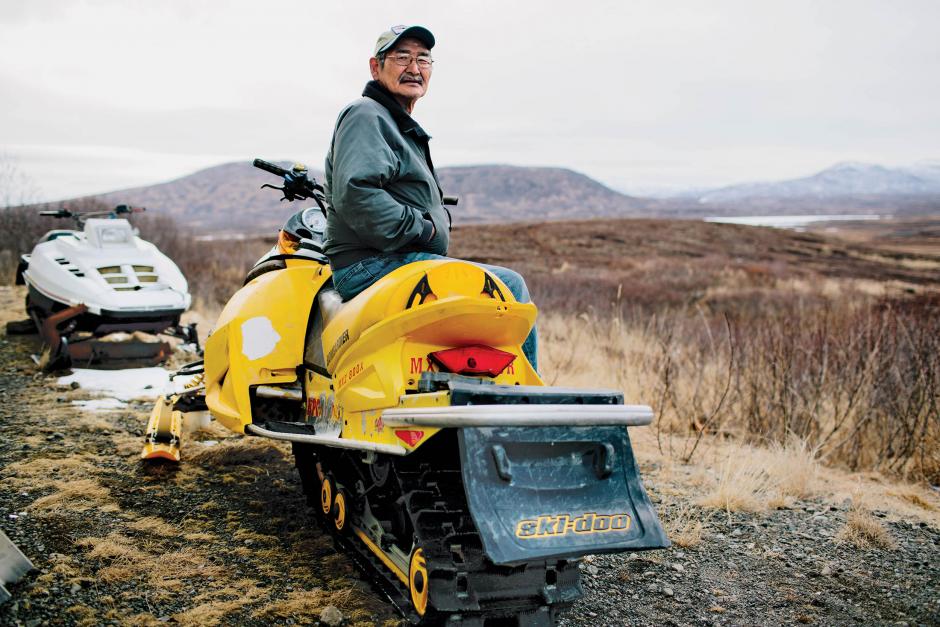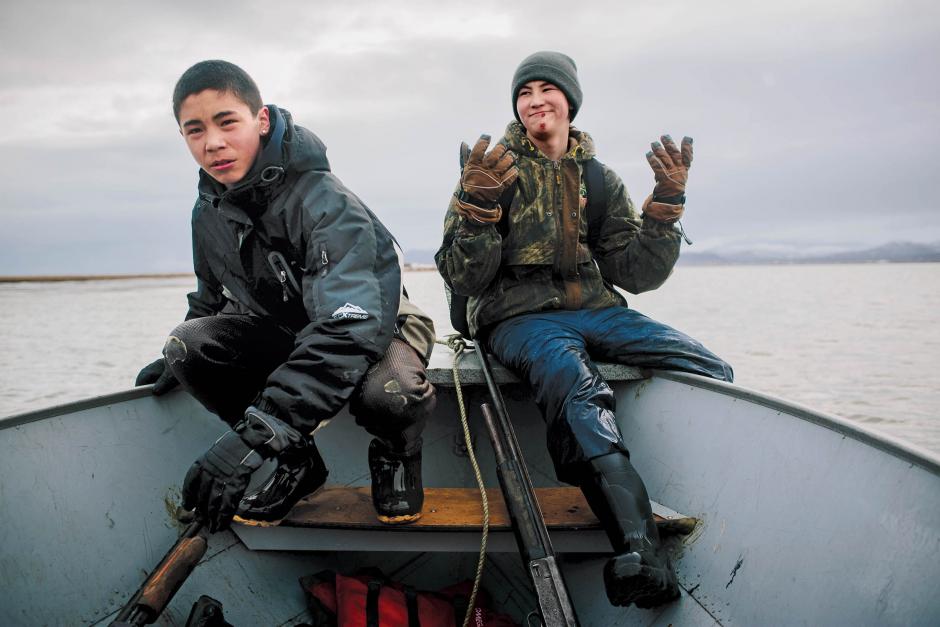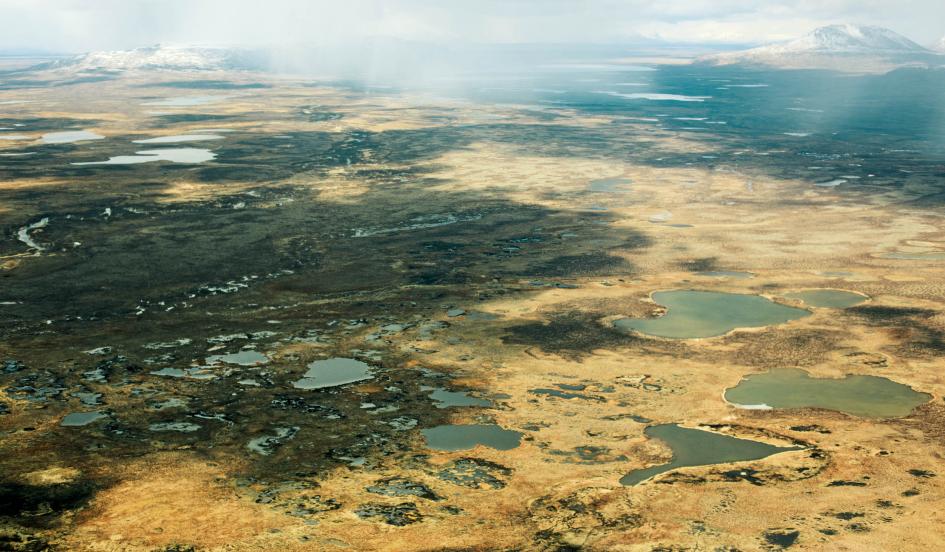BAKED ALASKA: A SNOWLESS CLIMATE THREATENS SURVIVAL OF YUPIK PEOPLE OF TOGIAK
By Lynnley Browning /NEWSWEEK
The Togiak National Wildlife Refuge, viewed from the air just East of Togiak, shows evidence of the winter’s limited snowfall. April 21, 2015. The Yupik people of Togiak are watching their world melt away from under their feet. Joshua Corbett for Newsweek
Frank Logusak, a tribal elder in Togiak, a ramshackle settlement of 842 people on Alaska’s remote Bristol Bay, is a hunter and a fisherman, a Yupik native who knew the village’s last shaman and can still build a sod house like the one his grandparents grew up in. Logusak is no scientist, but in his 64 years here, he has watched and felt startling changes in the world around him: shorter and warmer winters, less snow and ice, fewer bears and moose to hunt and increasingly scarce berries to gather in the summer.
For the last two winters, the village of Togiak has had almost no snow—a highly unusual phenomenon. In early April, the surrounding hills are barely dusted with a few patches of white. It is the same in the other 30 villages around Bristol Bay, on the easternmost frontier of the Bering Sea. The area is populated mostly by native Yupiks, descendants of fur-clad Siberians who crossed the Bering Land Bridge before the end of the last Ice Age 12,000 years ago.

06_05_Alaska_02 The town of Togiak, situated on the coast of Bristol Bay in Southwestern Alaska. Joshua Corbett for Newsweek
I fly to Togiak from Dillingham on an aging Cessna Caravan that threads its way through the 4,500-foot peaks of the Ahklun Mountains, whose glaciers, researchers say, are likely to disappear by the end of the century. From the air, I see wetlands and tundra largely bare of snow and Bristol Bay without the ice it should have this time of year. On a walk through town, I see smokehouses, steam bathhouses, hides drying on sheds and piles of scrap metal that evoke a cross between provincial Russia and Appalachia. An all-terrain vehicle pulls children on a pink sled through the mud.
“It’s a problem, the global warming,” Logusak says, sitting at a lunch table at the village’s public school, where older residents join students for government-subsidized free meals. “Ice used to stay in the bay until May,” he says. “It’s way different now.”
06_05_Alaska_03 Frank Logusak sits on his son’s snowmobile behind his home in Togiak Alaska on April 22, 2015. The past winter’s limited snowfall made accessing hunting grounds more difficult for hunters in the community. Joshua Corbett for Newsweek
Logusak and the two dozen villagers with whom I later spoke do not use the scientific jargon of climate change, but everyone describes what is obvious to them: Earth is getting warmer, making everything more difficult for one of North America’s last cultures that survive off the land and the sea. “Togiak is a dust bowl. I can see it from across the bay,” reads a mid-April Facebook post by Tim Bob Wonhola Jr., a native resident of Twin Hills, a neighboring village that, like Togiak, is accessible only by plane or boat.
From Alaska to Africa’s Kalahari Desert to the Amazon, indigenous communities have been among the hardest hit by climate change, because their way of life is so dependent on nature. “Indigenous peoples are the canary in the coal mine,” says Nancy Maynard, a retired NASA scientist who was lead author of the polar regions section of the most recent Intergovernmental Panel on Climate Change report.
The Yupiks who inhabit Togiak are the largest of three indigenous groups in Alaska and eastern Canada called Eskimo (the ethnographic and linguistic term is not considered offensive by native residents). Logusak was appointed to the Traditional Council of Togiak, the town’s governing body, at the unusually young age of 19; he is now vice president. He played a key role in pushing Alaskan state and federal authorities to reopen the nearby Walrus Islands to subsistence hunting in 1995, more than three decades after Alaska banned the tradition. The U.S. Fish and Wildlife Service allots the entire village of Togiak a “community harvest” of two walruses, with the meat, blubber and skin shared and bartered among households, sometimes with neighboring villages.
06_05_Alaska_04 Hunters use ATVs to retrieve their boat at the village boat launch in Togiak, Alaska on April 21, 2015. Joshua Corbett for Newsweek
The guttural Yupik language spoken by many in Togiak, and exclusively by some of the oldest tribal elders, has no word for “subsistence.” Hunting, fishing and foraging are not quaint traditions; they are the anchors of Yupik life and culture—of yuuyaraq, which roughly means “the way of being a human.”
Some three-quarters of those over 16 in the village are not formally employed, and average per capita income is just $11,739, so subsistence skills are essential to survival. While two small general stores sell basics from cereal to jelly, the cost of flying them in makes prices astronomical (a 1.5-liter bottle of Wesson cooking oil retails for $25; a 25-pound bag of flour costs over $53). About 1 in 4 of the village’s approximately 200 households are below the poverty line. Anything more than a cut finger needing sutures or a bout of strep throat requires medevac by plane to Dillingham, 68 miles away.
The Real Locavores
Life in Togiak, as it does across all of bush Alaska, revolves around the constant quest for wild food that changes with the seasons. Winter is the time for ice fishing and hunting. The sockeye salmon run, the largest in the world, usually starts in late June, kicking off a frenzied four to five weeks when around half of Togiak households find work fishing commercially or jostle in smaller boats with big trawlers up from Washington. Summer is the time to pick salmonberries for mixing with Crisco and sugar to make akutaq, a Yupik diet staple known as “Eskimo ice cream.” In the fall, people gather “mouse foods”: horsetail, a tuber eaten raw with seal oil; sour dock, an edible grass used for green akutaq; and long grasses for weaving baskets.
06_05_Alaska_07 Remnants of broken down snowmobiles scavenged for parts lie in a heap in Togiak, Alaska, April 21, 2015. Joshua Corbett for Newsweek
Togiak hunters travel by snowmobile, with Ruger .222-caliber rifles, survival gear, a VHF radio, nets and fishing rods. Soft, snowless tundra is like quicksand; snowmobiles cannot travel 10 feet on it before they start to sink. The latest moose hunting season was a bust, says Logusak. Normally, he and others travel up to 80 miles on snowmobiles, called snow-gos, into the Togiak National Wildlife Refuge, an expanse about twice the size of Puerto Rico. With no snow, they had to stay closer to home. This year and last, they shot just 13 or 14 moose each winter season, barely a sixth of the harvest in prior years. Tracking brown bears was nearly impossible—you need snowy paw prints, says Logusak. “I tried, but I never did get no trail.”
From the two herds of roughly 150,000 caribou in the refuge, Togiak hunters bagged only 16 caribou in the fall of 2014 and one in the winter 2015 season, a fraction of the 268 designated for culling to keep the herd healthy. Another local favorite is the ptarmigan, a rotund bird that is roasted or made into stew, but this winter they stayed away on the inaccessible (and colder) slopes of the Kilbuck Mountains. “Ptarmigans haven’t come down for the last two years,” says Logusak, blaming the lack of snow on “too many jet planes, airplanes, ships, cars polluting the sky.”
Fishing through thin ice in the bay and river, in temperatures that topped the upper 40s in January, was dangerous and nearly impossible. For the last couple of years, it seems, at least one person in Togiak has fallen through thin ice in the middle of Bristol Bay and never re-emerged. The bay, which accounts for 40 percent of all salmon sold in the United States, is the source of around half of Togiak’s annual diet. This year, it has been largely free of ice since February, curtailing the normal season for ice fishing for herring and smelt by around four months.
Peter Lockuk Jr. and Jim Logusak launch a boat into Togiak Bay on a mission to trade ivory and native crafts with a herring processing ship at anchor 8 miles away. Joshua Corbett for Newsweek
An unusually warm winter brings changes in summer and fall too. In recent years, the sockeye salmon runs, a splendid profusion of scarlet-red fish with newly bottle-green heads muscling up the Togiak River and eight other rivers feeding into the bay, have come unexpectedly early and petered out quickly. This year’s run, which is expected to start mid-June, is forecast at 54 million, the biggest in two decades. More fish would seem to indicate a thriving Bristol Bay. But that’s not necessarily the case, according to Douglas Causey, a biological sciences professor and director of the Applied Environmental Research Center at the University of Alaska, Anchorage. This year’s run may include an unusually large number of young fish not ready to spawn now and in danger of not spawning in future years, given that warmer waters over time stress salmon, ultimately lowering reproductive and survival rates. So why so many salmon this year? An unusually cold winter from 2011 to 2012 (part of a pattern of extreme weather shifts) may have created a temporary population boom. That does not change the overarching trend, which has the population of chinook “king” salmon declining for at least 15 years.
Later in the year, from August through October, picking berries used to be an annual family activity. “It used to look like someone had taken buckets and spilled blackberries” over the tundra, says Margie Frost, a Togiak resident who grew up in Kasigluk, a village 129 miles northeast that saw only one-tenth of the normal snowfall this past winter. There were hardly any berries during the past two years, and likely won’t be many this fall, since the plants that produce berries need snow cover to survive the winter.
“There’s so much not normal stuff going on,” says Clara Ann Martin, 54, who is also on the Traditional Council of Togiak, during a birthday party for a friend’s young daughter. Ten years ago, Martin says, “elders said, ‘No, no, no, it’s not happening.’ But now they see the lack of snow, the tree growth, the lesions on caribou…. Climate change is happening in our face.”
Boston and suburban Connecticut got more snow this winter, over several days, than did Bristol Bay over the entire winter. Last summer, fish struggled to swim upstream and spawn or died in overcrowded creeks that were unusually shallow because of the low water level in Togiak Lake, caused by the warm winter before. “It’s affected everybody’s lifestyle,” says Martin. “There’s less hunting and there’s less experience. It affects the kids culturally.”
06_05_Alaska_08 Kobe Pauk drives his brother, Allen Pauk, through town on an ATV, the preferred method of summer transportation around Togiak, Alaska for young and old alike. April 22, 2015. Joshua Corbett for Newsweek
Goodbye, Winter
Last year was the warmest on record for the entire planet, with the difference in Bristol Bay, some 9 degrees Fahrenheit above normal, particularly extreme. The annual Iditarod sled dog race in March had to be moved farther north, from a largely snowless Anchorage to Fairbanks. In Alaska’s far north, at least a dozen villages, including Kivalina, Shaktoolik and Shishmaref, plan to relocate because warmer, higher seas have exacerbated coastal erosion, and seal and whale hunting have been curtailed by thinning sea ice.
The Western Alaska Landscape Conservation Cooperative is a research organization created and staffed by federal agencies and by University of Alaska scientists. Its projections for 2010 to 2019 show April and October temperatures in Dillingham, the heart of Bristol Bay, hovering within 1 degree of 32 degrees Fahrenheit, a rise of several degrees that threatens to cut a seven-month winter to five months. Winter will get even shorter in the long term, the study says. Over the period from 2090 to 2099, Bristol Bay will lose another two months of winter, with March and November no longer having freezing temperatures. That means over the next four or five generations, winter in Togiak may be reduced to just three months.
In recent years, researchers have enlisted a citizen’s brigade of Alaska natives in three dozen villages across Bristol Bay to help gather data on changes in their surroundings. People have been posting pictures online of unusual (or unusually early) bugs, fish or plants through so-called local environmental observer networks. (For example: the growth of pussy willow, used as a substitute for aspirin, spotted in January in Togiak, at least three months early, or bees in February in an Aleutian Islands village.) Sam Gosuk, the Togiak school principal, recalled his astonishment at seeing green grass shoots coming out of a river bank in January, four months early. He duly reported the sighting.
06_05_Alaska_06 Peter Lockuk Jr. and Jim Logusak (not pictured) pick up Jim’s brother Travis Logusak (l) and Brekin Gosuk (r) from the Togiak Bay shore east of town after an unsuccessful duck hunt on April 23, 2015. Joshua Corbett for Newsweek
Sitting in the school cafeteria with the younger generation around him, Logusak sees himself as a teacher. “Before we get worse,” he says, “I hope I pass on the knowledge. I hope somebody takes over the issues I’ve been working on to protect our subsistence way of life for so many years.”
Half of Togiak’s population are under the age of 18, and they are learning the subsistence way of life from tribal elders and in school. At a class led by Fanny Parker, a teacher of Yupik studies, students learn Yupik vocabulary and grammar, as well as how to make crocheted bullet holders and headbands; one student, Jordan Wassillie, 17, shows off handmade moccasins with deerskin soles, beaver trim and a hand-beaded Air Jordan logo. Only a handful of Togiak students go to college; most drop out by 10th grade. “Most kids want to stay and subsistence hunt and fish, and do commercial fishing,” says Shayla Schwoch, a high school English teacher originally from Auburn, Washington.
Back in Dillingham, the starting point for flights to Togiak, I thumb a ride from the airport to downtown with Tara Kregar, a high school math and science teacher in Dillingham who taught in Togiak last year. I ask if her students, in both places, are aware of climate change. She nods solemnly, then says, “I have students who ask if the world is coming to an end.”









Follow Us!